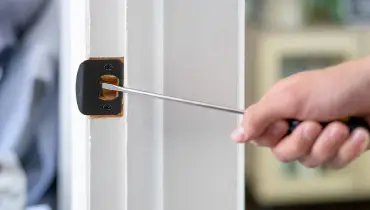
In this guide, we’ll explore how to address this common problem, whether you’re a novice or someone with a bit of DIY experience. We’ll break down the steps clearly and make sure you feel confident tackling this task. Plus, we’ll discuss what might cause the issue in the first place, and how to keep your door functioning smoothly moving forward. So grab your tools, and let’s get started!
Understanding The Components Of A Door Latch Bolt Assembly
To fix a loose door latch bolt assembly, you first need to understand what you’re working with. The latch bolt assembly consists of several key parts: the bolt itself, the strike plate (the piece attached to the door frame), and the latch mechanism that controls how the bolt operates.
The latch bolt is the part that extends into the strike plate when your door is closed. It keeps your door secure and ensures that it stays closed when you need it to. The strike plate is embedded in the door frame and guides the latch bolt, helping it lock properly. If either of these components is loose or damaged, you’ll likely run into problems.
By familiarizing yourself with these parts, you’ll be better equipped to identify any issues. For example, if the latch bolt doesn’t fully retract, it might be misaligned or obstructed. Knowing the components helps you troubleshoot effectively.
Common Causes of a Loose Door Latch Bolt Assembly
There are several reasons why your door latch might become loose over time. Often, it’s just wear and tear from daily use. When you open and close your door, the latch bolt can gradually loosen its fit. But there are other culprits to consider too:
- Humidity and Temperature Changes: Wood can expand and contract, which may cause misalignment.
- Screws Coming Loose: Over time, the screws holding the latch and strike plate may become loose.
- Worn Components: If the latch or strike plate is damaged or worn, it can lead to improper fitting.
You might be wondering how to tell if it’s a simple fix or if you need to replace a part entirely. Inspect each piece closely. If the screws are stripped or the latch bolt is broken, you may need to purchase replacements. But if it’s just misaligned, a little tightening of screws might do the trick.
Tools You’ll Need for the Repair
Now that you understand the problem, it’s time to gather your tools. Having everything on hand can save you time and frustration. Here’s what you’ll typically need:
- Screwdriver: A standard or Phillips screwdriver, depending on your screws.
- Drill: Useful if you need to replace screws or drill new holes.
- Level: To ensure everything is aligned properly.
- Wood Glue: Optional, in case you need to reinforce a wooden door frame.
With these tools, you’ll be well-equipped to handle the job. If you don’t have something, it’s a good idea to pick it up before starting to avoid interruptions mid-repair.
Steps to Repair a Loose Door Latch Bolt Assembly
Let’s dive into the repair process. Follow these steps, and you’ll have your latch bolt assembly back in working order in no time:
Step 1: Inspect the Assembly
Begin by inspecting the latch bolt and strike plate closely. Look for any visible signs of wear, such as gaps between the door and frame.
Step 2: Tighten Screws
Use your screwdriver to tighten any loose screws that attach the latch to the door and the strike plate to the frame. A simple twist can make a big difference.
Step 3: Realign the Latch
If the latch isn’t lining up with the strike plate, try pulling or pushing the door gently to see if it can be adjusted.
Step 4: Test the Mechanism
After making adjustments, close the door and check if the latch engages smoothly. You might need to adjust further if it still feels off.
When to Replace Components
Sometimes, your latch bolt assembly might need a bit more TLC than just tightening screws. Here’s when you should consider replacing components:
- Worn Out Parts: If the bolt or latch shows significant wear or damage, replacement is necessary.
- Stripped Screws: If screws won’t tighten, they might be stripped and need replacing.
- Inconsistent Functioning: If you consistently have to tweak the latch for it to work, you may need a new assembly.
Replacing parts can seem daunting, but it’s often straightforward. Just make sure you measure correctly, so everything fits snugly.
Preventing Future Issues
Once you’ve fixed your latch bolt assembly, you’ll want to keep it running smoothly. Here are some tips to prevent future problems:
- Regular Maintenance: Check screws and alignment every few months.
- Be Gentle: Avoid slamming doors; this can wear out the latch faster.
- Consider a Weather Strip: Install one around the door frame to minimize temperature changes affecting wood.
Maintaining your door latch will save you time and hassle down the road. Plus, it keeps your home secure and energy-efficient.
Repairing a loose door latch bolt assembly might seem like a small task, but it’s crucial for keeping your home safe and comfortable. By knowing what causes the issue, the tools you need, and the steps to take, you’re now equipped to tackle this problem confidently.
Remember, a well-functioning latch not only enhances security but also adds to the overall comfort of your home. Keep an eye on your door hardware, and don’t hesitate to make repairs as needed. After all, a little maintenance goes a long way!